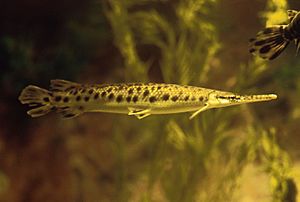Neopterygii facts for kids
Quick facts for kids NeopterygiiTemporal range: Late Permian - Recent
|
|
|---|---|
 |
|
| Gar fish | |
| Scientific classification | |
| Kingdom: | |
| Phylum: | |
| Class: | |
| Subclass: |
Neopterygii
|
| Infraclasses | |
Neopterygii (say: Nee-op-TER-ih-jee-eye) is a very successful group of fish. Their name means "new fins." These fish first appeared a long, long time ago in the Late Permian period. This was even before the time of the dinosaurs!
Neopterygii are special because they can move much faster than their older fish relatives. Over time, their bodies changed. Their scales and skeletons became lighter, which helped them swim more easily. Also, their jaws became stronger and better at catching food. These changes helped them become one of the most common groups of fish we see today.
How Neopterygii Evolved
Neopterygii fish evolved from an older group called Actinopterygii. While they share many features, Neopterygii developed some key improvements. These changes helped them survive and thrive in many different water environments.
Lighter Bodies and Stronger Jaws
One big change was how light their bodies became. Their scales got thinner and more flexible. Their skeletons also became lighter. This made it easier for them to swim quickly and turn sharply.
Another important change was their jaws. Neopterygian fish developed more powerful and efficient jaws. This meant they could bite harder and catch their prey more easily. These improvements helped them become very successful hunters.
Images for kids
-
Early Triassic parasemionotiform Watsonulus is an early neopterygian
See also
 In Spanish: Neopterigios para niños
In Spanish: Neopterigios para niños


